Browser redirect virus (spam) - 2020 update
Browser redirect virus Removal Guide
What is Browser redirect virus?
Browser redirect virus is a PUP that deteriorates your browsing experience
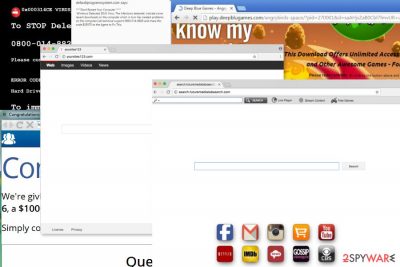
Browser redirect virus is a browser hijacker[1] which takes over the targeted browser, for example, Google Chrome, Mozilla Firefox, Internet Explorer, Safari, etc. This potentially unwanted program (PUP) can significantly worsen the experience during your browsing sessions as it causes continuous redirects to affiliate websites, prevents from using a safe search engine, and displays advertising content.
Getting infected with a Browser redirect virus is easy – all you need to do is to install freeware [2] inattentively. If you skip a pre-selected agreement to replace your current search engine or overlook other third-party entries bundled in a software package, you might deal with unwanted activities on your browser.
After the hijack, Redirect virus might:
- modify default homepage,
- replace current search engine with an unknown domain,
- display intrusive ads,
- initiate redirects to questionable sites,
- track information about users,
- etc.
| Name | Browser redirect virus |
|---|---|
| Type | Browser hijacker |
| Affected browsers | Safari, Mozilla Firefox, Internet Explorer, Google Chrome, etc. |
| Distribution | It is delivered together with freeware and shareware by a bundling scheme |
| Danger level | Medium |
| Symptoms | Once it is installed, it can alter browser settings and modify the new tab URL, homepage, and the default search engine. Later, delivers an excessive amount of intrusive ads and redirects to unknown websites with commercial content |
| Potential dangers | Redirects and displayed ads on frequently visited pages might be potentially dangerous and increase the risk of getting infected with malware. Also, due to information tracking users can no longer feel safe about their privacy and encounter privacy-related issues |
| Removal | You can uninstall the virus automatically by resetting the affected web browser |
| Fix | To revert virus damage, use FortectIntego |
If you are being redirected to delta-homes.com, YourSites123.com, or search protect while browsing through Google, Yahoo, Bing or some shady domains load immediately after you launch your browser, take it as a tell-tale sign that your computer has been infected with a Browser redirect malware.
Nevertheless, applications belonging to this category are not malicious themselves; redirects, ads, and links might lead to potentially dangerous websites.[3] Thus, you might be redirected to an infected site that has been created for spreading malware, fake tech support site, phishing site, or become a victim of other online crimes.
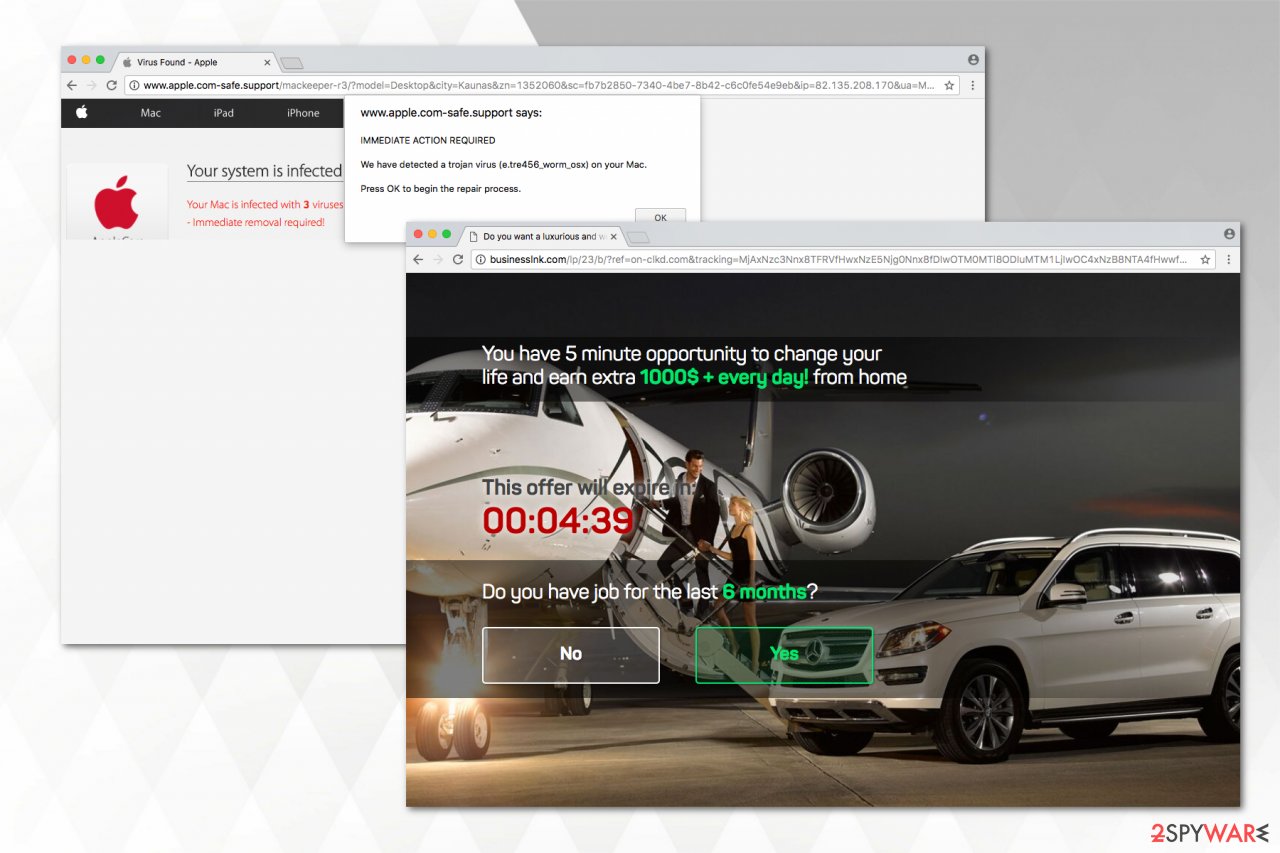
In addition, it can easily track your browsing habits and collect information related to your browsing habits, such as your search queries, most visited websites, information that you submit when visiting these sites, your computers' IP address and location. This information is considered personally non-identifiable [4], but its leaks can result in various issues, including an increased amount of spam, more aggressive targeted advertising, and similar problems.
Noticing strange activities on the browser is a sign that you should take care of the computer’s security and focus on Browser redirect removal. There are numerous types and versions of these cyber infections; however, they all should be treated either automatically using anti-malware software or manually by investigating the system and deleting all malware-related entries yourself.

If you suspect your device has been taken hostage by a browser hijacker, you should remember that you can always remove Browser redirect virus with the help of automatic security utilities such as SpyHunter 5Combo Cleaner or Malwarebytes. To remediate issues caused by the virus, try FortectIntego.
Learn how to avoid browser hijackers and other PUPs
Usually, various potentially unwanted programs (PUPs) and browser redirect viruses are distributed together with free applications via a popular marketing scheme called bundling. This technique allows the developers of browser hijackers to hide their software among the optional components in the installer of other programs. Likewise, people unconsciously install both, freeware and PUP if they do not pay attention during the procedure.
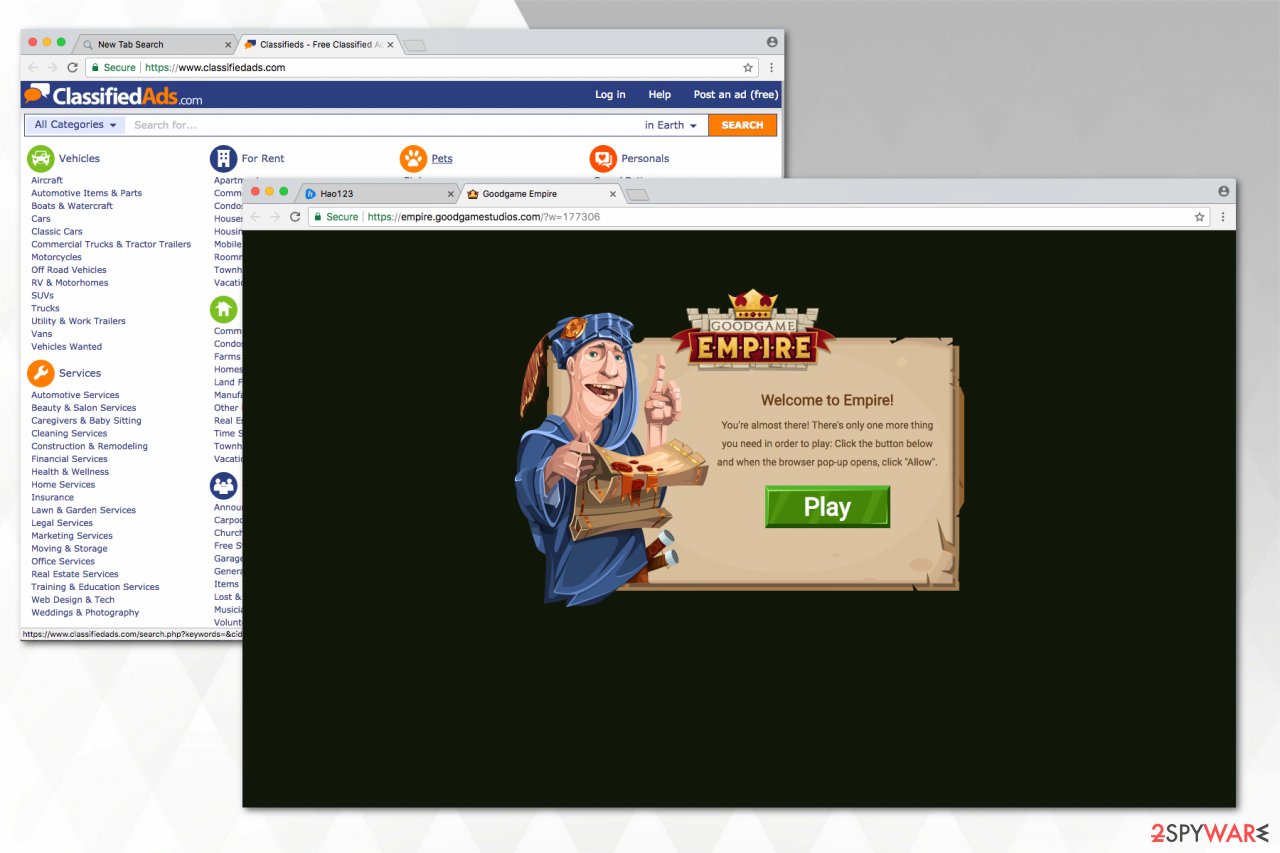
Although, there are some tips that can help you protect your computer from browser hijackers and allow downloading free software. Make sure, that you read the steps indicated below attentively.
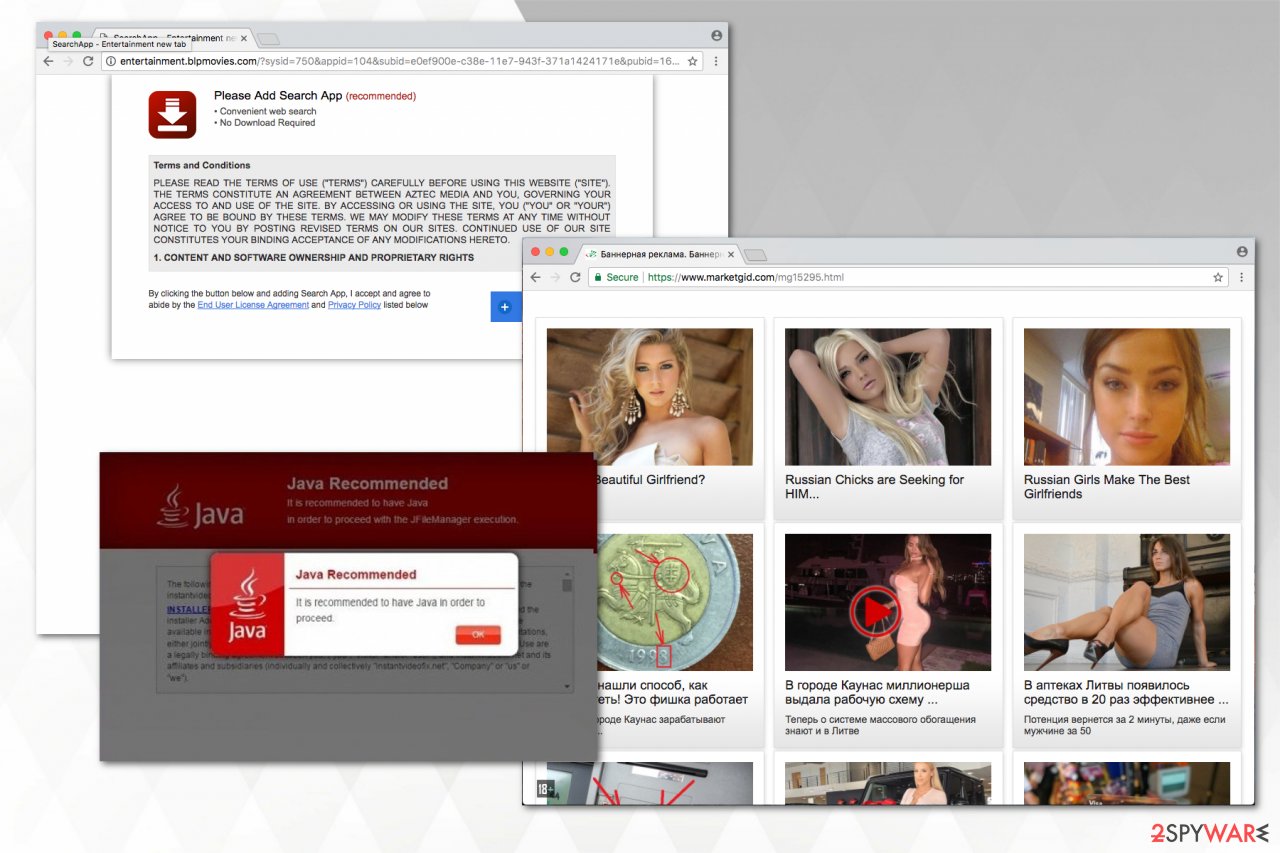
Read the “Privacy Policy” and “End User's License Agreement.” If there are any mentions about data collection, commercial content, and similar things, you should look for another, more reliable service.
- Avoid “Quick,” “Basic” or “Recommended” installation option;
- Select “Custom” or “Advanced” installation modes;
- Remain attentive when going through the installation wizard and carefully read the information provided within each of the installation windows;
- If you see any pre-checked option allowing to make changes to your start page or the default search engine, you should uncheck them;
- Decline offers to install unknown browser add-ons, extensions, and plugins on your computer [5];
- Install reputable anti-spyware and keep it up-to-date. It will help you avoid browser hijackers that may be hidden inside the freeware packages.
Ways to get rid of Browser redirect virus
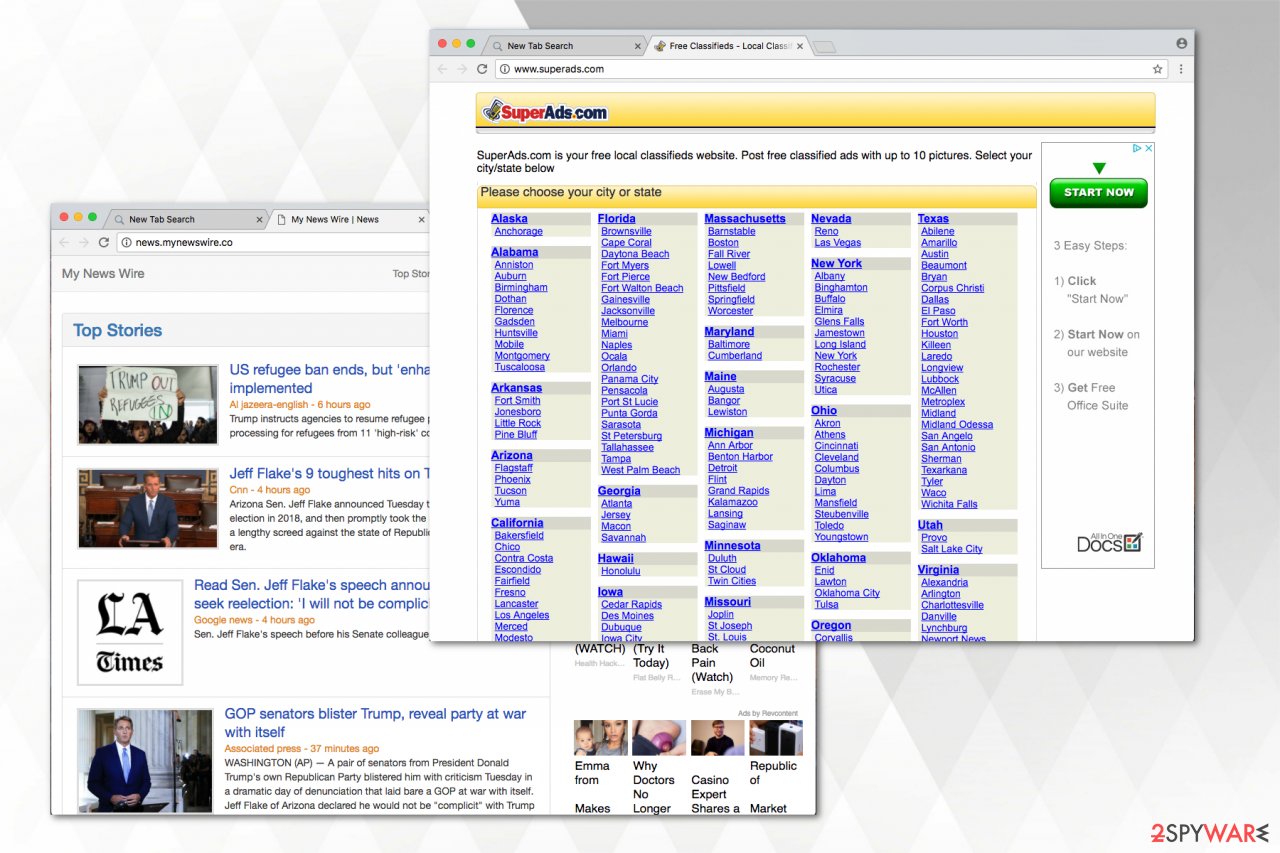
Before you try to remove Browser redirect virus, keep in mind that the procedure might be tricky as such PUPs tend to reappear after some time. Likewise, we suggest you rely on an automatic elimination method. It merely requires you to download a professional antivirus and let it check your computer files. After you run a scan with the preferred security tool, we strongly recommend FortectIntego to get rid of corrupted system files that might have been affected by the virus.
To perform virus removal manually, find the instructions at the end of the post. However, if suspicious activities won't stop, you should opt for the automatic option then. Security tools will find and delete malicious entries that you have missed.

We want to point out that it’s important to remove virus-related components from each of the web browsers that are installed on your computer. Besides, you have to reset Internet Explorer, Edge, Chrome, Firefox, Safari, Opera or another browser you use. We have prepared guidelines on how to terminate suspicious entries from these browsers below.
Instructions to remove Browser redirect from Mozilla Firefox
Firefox redirect virus removal can be tricky, as some additional components prevent you from changing the modified browser's settings to the primary state. Thus, you must search for and delete all suspicious and unknown extensions or plug-ins that might be related to the browser hijacker.
You can check your extensions by following this path:
- Firefox;
- Add-ons;
- Extensions.
Here you will see current active toolbars and other applications. If you find some unknown entries, remove them.

However, sometimes computer infections hide under legitimate and popular program names. Usually, malicious or potentially dangerous applications use the name of Flash Player. However, keep in mind that seeing Flash Player under the extensions tab is suspicious. It should not appear here.
In addition to extension removal, you have to reset the browser as well. You can do that by following these steps:
- Click on the Firefox menu.
- Choose Troubleshooting Information.
- You will Reset Firefox to its default state option.
- Click Reset Firefox button.
However, if you continue to see suspicious ads, cannot replace the default homepage, and deal with similar problems, you should lookup up the virus-related programs in the computer’s system and uninstall potentially dangerous programs.
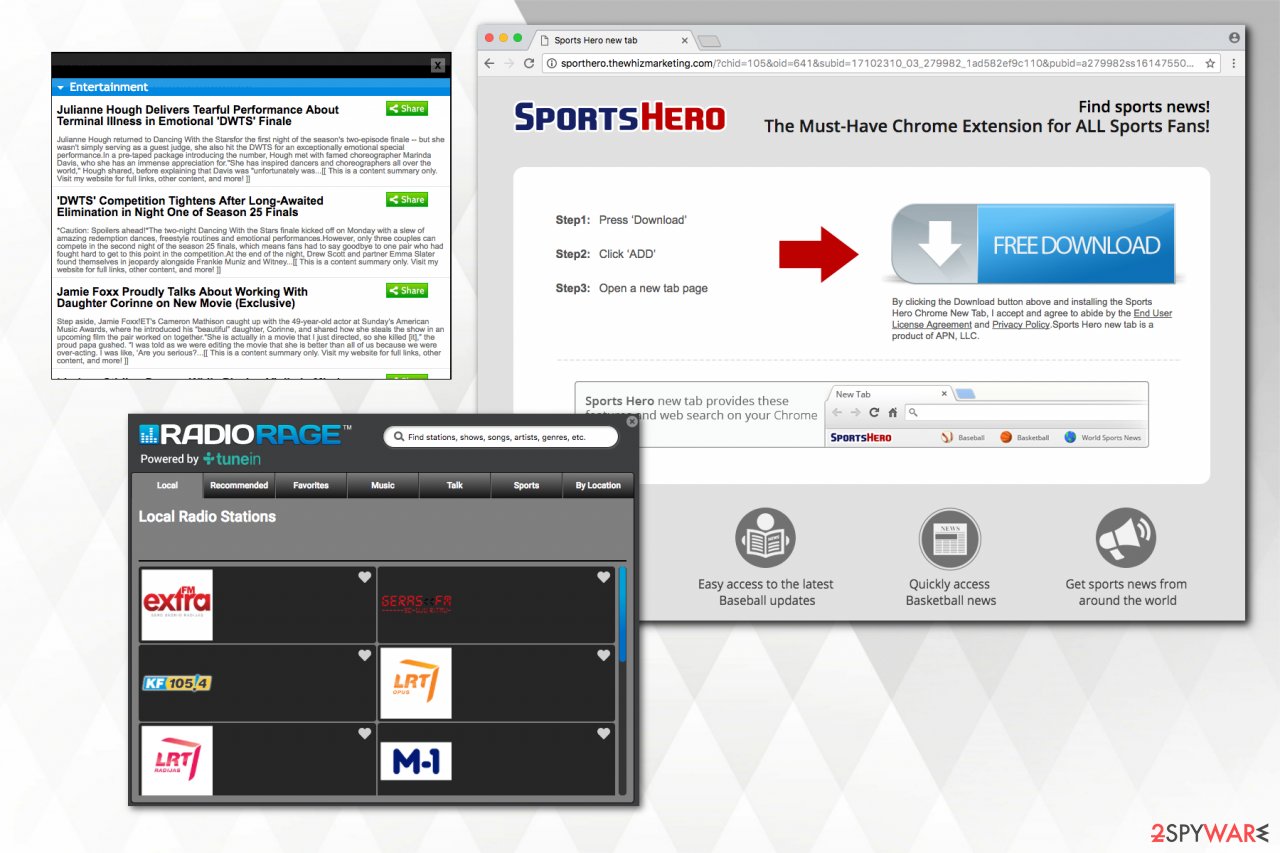
Guide to uninstall the virus from Google Chrome
The easiest way to find out that Chrome redirect virus is present on your computer is to check whether your default search provider is set to an unknown search engine. Keep in mind that the imposters usually try to look similar to popular search directories. Although, if you encounter suspicious redirects when clicking on query results, your browser is surely hijacked.
This cyber threat might also display various ads and pop-ups that are connected or related to Google. These problems might be caused by Trojans, Rootkits, or suspicious browser extensions that may have been installed with freeware or shareware.
In order to get back access to the browser and get rid of these redirects, users have to look through the list of installed extensions and remove suspicious entries. You can access Chrome’s extensions by opening:
- Chrome’s settings;
- Tools;
- Extensions.
Once you remove them, you should reset the browser via Reset browser settings options in Chrome’s settings.
However, if you cannot find potentially dangerous extensions installed on the browser, you should look up suspicious programs installed on your PC. If you cannot find anything unknown, you should scan the computer with a reputable malware removal program. Most likely you are dealing with a more serious infection than a browser redirect virus.
Delete redirect malware from Internet Explorer
The main feature of browser hijackers is that they can lead the user to shady and suspicious websites. Note that it happens once you perform the search and appear on Google, Bing, or Yahoo site where links are provided. Despite how legitimate it looks, the indicated links redirect to affiliate and commercial sites.
Although, the significant feature of the IE redirect virus is that it can employ browser helper objects (BHO) to launch undesired tasks on the browser. For instance, the hijacker might alter the browser’s settings, set a new search engine, or install third-party extensions.
To check if suspicious BHO’s have been installed to the Explorer, you can follow these steps:
- Open the browser.
- Choose Tools.
- Select Manage Add-Ons.
- Look through the list and remove suspicious entries.
If you cannot find unknown add-ons or Explorer continues causing problems, you should not hesitate and run a system scan with malware removal programs.
Measures to take once the Safari is hijacked by redirect virus



The main problem you can encounter after the Mac redirect virus starts its malicious activity is the redirect to various non-English speaking sites. Unfortunately, most of the websites this browser hijacker leads to are potentially dangerous, including tech support scam pages or websites aimed at malware distribution.
Usually, these activities are triggered by some Safari extensions. Even if you haven’t installed any extensions, plugins, or toolbar directly, it may have entered bundled when you downloaded some application from third-party sources.
To stop these activities, you have to look through the list of your extensions:
- Open Safari.
- Click on Safari in the main menu section.
- Select Preferences.
- Open Extensions tab.
- Click the Uninstall button near each of the suspicious components.
Once all potentially dangerous entries are deleted, you have to reset the browser. It helps to delete tracking cookies and other elements that are related to browser redirect virus.
Cleaning Opera from redirect issues
Once Opera is infected with the virus, users may receive numerous and intrusive pop-ups, banners, and in-texts on frequently visited pages. Also, when performing a query, the search engine redirects to unknown pages and shady websites, including gambling, and adult-only sites.
After the hijack, users might also find unknown toolbars or extensions installed in the browser. The problem is that some of them might be responsible for flooding the browser with ads and tracking various information.
Once your browsing sessions are disturbed by these activities, you should check the list of extensions and add-ons:
- Open the browser.
- Choose Tools.
- Click on Extensions.
- Select Manage Extensions.
If you cannot find any suspicious entries installed, you should opt for the automatic elimination option and let anti-malware to eliminate Safari redirect virus.
You may remove virus damage with a help of FortectIntego. SpyHunter 5Combo Cleaner and Malwarebytes are recommended to detect potentially unwanted programs and viruses with all their files and registry entries that are related to them.
Getting rid of Browser redirect virus. Follow these steps
Uninstall from Windows
Instructions for Windows 10/8 machines:
- Enter Control Panel into Windows search box and hit Enter or click on the search result.
- Under Programs, select Uninstall a program.


- From the list, find the entry of the suspicious program.
- Right-click on the application and select Uninstall.
- If User Account Control shows up, click Yes.
- Wait till uninstallation process is complete and click OK.


If you are Windows 7/XP user, proceed with the following instructions:
- Click on Windows Start > Control Panel located on the right pane (if you are Windows XP user, click on Add/Remove Programs).
- In Control Panel, select Programs > Uninstall a program.


- Pick the unwanted application by clicking on it once.
- At the top, click Uninstall/Change.
- In the confirmation prompt, pick Yes.
- Click OK once the removal process is finished.
Delete from macOS
Remove items from Applications folder:
- From the menu bar, select Go > Applications.
- In the Applications folder, look for all related entries.
- Click on the app and drag it to Trash (or right-click and pick Move to Trash)


To fully remove an unwanted app, you need to access Application Support, LaunchAgents, and LaunchDaemons folders and delete relevant files:
- Select Go > Go to Folder.
- Enter /Library/Application Support and click Go or press Enter.
- In the Application Support folder, look for any dubious entries and then delete them.
- Now enter /Library/LaunchAgents and /Library/LaunchDaemons folders the same way and terminate all the related .plist files.


Remove from Microsoft Edge
Delete unwanted extensions from MS Edge:
- Select Menu (three horizontal dots at the top-right of the browser window) and pick Extensions.
- From the list, pick the extension and click on the Gear icon.
- Click on Uninstall at the bottom.


Clear cookies and other browser data:
- Click on the Menu (three horizontal dots at the top-right of the browser window) and select Privacy & security.
- Under Clear browsing data, pick Choose what to clear.
- Select everything (apart from passwords, although you might want to include Media licenses as well, if applicable) and click on Clear.


Restore new tab and homepage settings:
- Click the menu icon and choose Settings.
- Then find On startup section.
- Click Disable if you found any suspicious domain.
Reset MS Edge if the above steps did not work:
- Press on Ctrl + Shift + Esc to open Task Manager.
- Click on More details arrow at the bottom of the window.
- Select Details tab.
- Now scroll down and locate every entry with Microsoft Edge name in it. Right-click on each of them and select End Task to stop MS Edge from running.


If this solution failed to help you, you need to use an advanced Edge reset method. Note that you need to backup your data before proceeding.
- Find the following folder on your computer: C:\\Users\\%username%\\AppData\\Local\\Packages\\Microsoft.MicrosoftEdge_8wekyb3d8bbwe.
- Press Ctrl + A on your keyboard to select all folders.
- Right-click on them and pick Delete


- Now right-click on the Start button and pick Windows PowerShell (Admin).
- When the new window opens, copy and paste the following command, and then press Enter:
Get-AppXPackage -AllUsers -Name Microsoft.MicrosoftEdge | Foreach {Add-AppxPackage -DisableDevelopmentMode -Register “$($_.InstallLocation)\\AppXManifest.xml” -Verbose


Instructions for Chromium-based Edge
Delete extensions from MS Edge (Chromium):
- Open Edge and click select Settings > Extensions.
- Delete unwanted extensions by clicking Remove.


Clear cache and site data:
- Click on Menu and go to Settings.
- Select Privacy, search and services.
- Under Clear browsing data, pick Choose what to clear.
- Under Time range, pick All time.
- Select Clear now.


Reset Chromium-based MS Edge:
- Click on Menu and select Settings.
- On the left side, pick Reset settings.
- Select Restore settings to their default values.
- Confirm with Reset.


Remove from Mozilla Firefox (FF)
Remove dangerous extensions:
- Open Mozilla Firefox browser and click on the Menu (three horizontal lines at the top-right of the window).
- Select Add-ons.
- In here, select unwanted plugin and click Remove.


Reset the homepage:
- Click three horizontal lines at the top right corner to open the menu.
- Choose Options.
- Under Home options, enter your preferred site that will open every time you newly open the Mozilla Firefox.
Clear cookies and site data:
- Click Menu and pick Settings.
- Go to Privacy & Security section.
- Scroll down to locate Cookies and Site Data.
- Click on Clear Data…
- Select Cookies and Site Data, as well as Cached Web Content and press Clear.


Reset Mozilla Firefox
If clearing the browser as explained above did not help, reset Mozilla Firefox:
- Open Mozilla Firefox browser and click the Menu.
- Go to Help and then choose Troubleshooting Information.


- Under Give Firefox a tune up section, click on Refresh Firefox…
- Once the pop-up shows up, confirm the action by pressing on Refresh Firefox.


Remove from Google Chrome
Delete malicious extensions from Google Chrome:
- Open Google Chrome, click on the Menu (three vertical dots at the top-right corner) and select More tools > Extensions.
- In the newly opened window, you will see all the installed extensions. Uninstall all the suspicious plugins that might be related to the unwanted program by clicking Remove.


Clear cache and web data from Chrome:
- Click on Menu and pick Settings.
- Under Privacy and security, select Clear browsing data.
- Select Browsing history, Cookies and other site data, as well as Cached images and files.
- Click Clear data.


Change your homepage:
- Click menu and choose Settings.
- Look for a suspicious site in the On startup section.
- Click on Open a specific or set of pages and click on three dots to find the Remove option.
Reset Google Chrome:
If the previous methods did not help you, reset Google Chrome to eliminate all the unwanted components:
- Click on Menu and select Settings.
- In the Settings, scroll down and click Advanced.
- Scroll down and locate Reset and clean up section.
- Now click Restore settings to their original defaults.
- Confirm with Reset settings.


Delete from Safari
Remove unwanted extensions from Safari:
- Click Safari > Preferences…
- In the new window, pick Extensions.
- Select the unwanted extension and select Uninstall.


Clear cookies and other website data from Safari:
- Click Safari > Clear History…
- From the drop-down menu under Clear, pick all history.
- Confirm with Clear History.


Reset Safari if the above-mentioned steps did not help you:
- Click Safari > Preferences…
- Go to Advanced tab.
- Tick the Show Develop menu in menu bar.
- From the menu bar, click Develop, and then select Empty Caches.


After uninstalling this potentially unwanted program (PUP) and fixing each of your web browsers, we recommend you to scan your PC system with a reputable anti-spyware. This will help you to get rid of Browser redirect registry traces and will also identify related parasites or possible malware infections on your computer. For that you can use our top-rated malware remover: FortectIntego, SpyHunter 5Combo Cleaner or Malwarebytes.
How to prevent from getting browser hijacker
Access your website securely from any location
When you work on the domain, site, blog, or different project that requires constant management, content creation, or coding, you may need to connect to the server and content management service more often. The best solution for creating a tighter network could be a dedicated/fixed IP address.
If you make your IP address static and set to your device, you can connect to the CMS from any location and do not create any additional issues for the server or network manager that needs to monitor connections and activities. VPN software providers like Private Internet Access can help you with such settings and offer the option to control the online reputation and manage projects easily from any part of the world.
Recover files after data-affecting malware attacks
While much of the data can be accidentally deleted due to various reasons, malware is one of the main culprits that can cause loss of pictures, documents, videos, and other important files. More serious malware infections lead to significant data loss when your documents, system files, and images get encrypted. In particular, ransomware is is a type of malware that focuses on such functions, so your files become useless without an ability to access them.
Even though there is little to no possibility to recover after file-locking threats, some applications have features for data recovery in the system. In some cases, Data Recovery Pro can also help to recover at least some portion of your data after data-locking virus infection or general cyber infection.
- ^ Fix your hijacked web browser. Microsoft. Microsoft Safety and Security Center.
- ^ Freeware vs Shareware vs Open Source. OpenSourceStrategies. IT-related blog.
- ^ URL Redirect. Techopedia. Where IT and Business Meet.
- ^ What is the difference between sensitive PII and non-sensitive PII?. Quora. A place to share knowledge and better understand the world.
- ^ Cat Ellis. Avoid and remove potentially unwanted programs (PUPs). Techradar. The source for tech buying advice.
